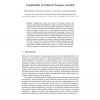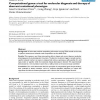27 search results - page 2 / 6 » Computationally Optimised DNA Assembly of synthetic genes |
GG
2004
Springer
13 years 10 months ago
2004
Springer
that graph transformations provide the right level of abstraction, and useful technical tools for studying gene assembly. On the other hand, the gene assembly process inspires a ne...
WABI
2007
Springer
13 years 11 months ago
2007
Springer
Graph-theoretic models have come to the forefront as some of the most powerful and practical methods for sequence assembly. Simultaneously, the computational hardness of the underl...
TAPIA
2009
ACM
13 years 11 months ago
2009
ACM
Genomics has reached the stage at which the amount of DNA sequence information in existing databases is quite large. Synthetic biology is now using these databases to catalog sequ...
DNA
2006
Springer
13 years 8 months ago
2006
Springer
Self-repair is essential to all living systems, providing the ability to remain functional in spite of gradual damage. In the context of self-assembly of self-repairing synthetic b...
BMCBI
2007
13 years 4 months ago
2007
Background: A finite state machine manipulating information-carrying DNA strands can be used to perform autonomous molecular-scale computations at the cellular level. Results: We ...


